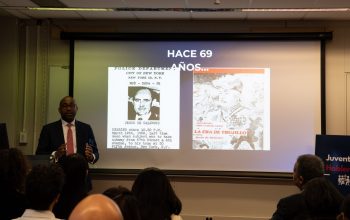news
“Jesus, the Greatest Leader in History”, an article by Dr. Leonel Fernández
April 6, 2015
More than 2,000 years have passed since he was among us. His public life was extremely short, extending over just three decades. He had a team of collaborators of scarcely a dozen people. At the time of his death, his supporters did not exceed more than several hundred. He left no writings.
Nonetheless, with more than a billion current followers of all races and languages in all corners of the planet, he is without a doubt the greatest leader in
history—the most transcendent of all time.
He was called Jesus. He was born in a manger in the city of Bethlehem, then part of the Roman empire. His father was a carpenter named Joseph, and his mother Mary, according to sacred writings, had conceived him by the work and grace of the Holy Spirit, thereby granting him divinity.
From the moment of his birth, Jesus caused concerns and fears. King Herod the Great was particularly disturbed when some wise men
from the East told him they had come following a star with the aim of paying their respects the King of the Jews, who had just been born.
In the face of this news Herod tried to trick the wise men into revealing Jesus’s exact place of birth, but when that was not possible, he grew angry and ordered the murder of all children under age two in Bethlehem and the surrounding areas.
This cruel and atrocious measure of wishing to eliminate a child
that could not yet represent any real threat to the established power was nonetheless unequivocal proof of the Roman authorities’ fear of anything that could challenge that epoch’s regime of colonial domination over what is now Israel, Palestine, Jordon, Syria, and Lebanon.
Jesus managed to avoid being murdered, as his parents had been warned by an angel that they should flee to Egypt, where they lived until the death of Herod. They later
returned to Israel, to Nazareth, a poor city in the Galilee region.
Jesus’s leadership
Before Jesus’s birth, the people of Israel had for centuries been awaiting the arrival of the Messiah, that is, a savior, a great prophet, or a great king. This was recorded in several Old Testament texts, in particular in the prophecies of Isaiah, Jeremiah, Zachariah, Micah, Hosea, and the Psalms.
That this
long-awaited Messiah was Jesus was established, among other acts, by his baptism by John the Baptist. On that occasion, he received a divine sign in which, according to the story in the Gospel of Luke, “the Holy Ghost descended in a bodily shape like a dove upon him, and a voice came from heaven, which said, Thou art my beloved Son; in thee I am well pleased.”
Of course, this was not accepted by everyone, as the expected Messiah was not assumed to be
the humble son of a carpenter who rode atop a donkey. It was believed the Messiah should have the lineage of a king, and in the eyes of certain sectors, that was not Jesus’s case.
After his baptism, Jesus was led by God, his father, to the desert, where he fasted for forty days, and at the end of this period of consecration the devil arrived with a temptation, which Jesus rejected.
After this episode, from the age of 30, he began to organize a
group of disciples and preach in different towns, and it was then that he properly launched his cause to save humanity, offering forgiveness for sins, eternal life, and the kingdom of heaven.
Jesus’s leadership began to develop based on his simple messages, transmitted in the form of parables, as well as on the many miracles he did, healing the sick, casting out impure spirits, doing resurrections, multiplying food, and performing natural wonders like walking on
water and calming tempests.
His revolutionary doctrine of solidarity with the poor and oppressed was eloquently expressed in the Sermon on the Mount, where, among other things, he championed those who have a hunger and thirst for justice, those who suffer pain, those who are insulted and defamed, and those who are unjustly persecuted.
The actions and messages of Christ drew the interest of multitudes, who gathered in throngs to received him. But his
popularity and influence began to cause mistrust and suspicion among the leaders of the religious sects of the Pharisees and Sadducees, as well as among the Roman political authorities.
The first thing they did in response was attempt to morally discredit him with falsehoods, such as that he was “a man gluttonous, and a winebibber, a friend of publicans and sinners.”
Naturally, this was all nonsense. But the idea that Jesus was a
friend of tax collectors aimed to make him the target of the disdain the Jewish people felt for these officials, who often abused their functions, acted arbitrarily, extorted, and blackmailed.
From slander to the crucifixion
With time Jesus returned to Nazareth, where he was not well received by those who already opposed him, prompting him to note that “no prophet is accepted in his own country.” He then went to
Capernaum, on the northeast coast of the Sea of Galilee, which became his operations base.
From there he pressed on with his project, developing his ministry, overcoming the slander, and working to help the most needy, while the religious and political authorities of the period slowly put together a plan to destroy him.
The reasons for this hostility were related with the fact that they considered Jesus a threat to their interests, which were closely
linked to the power of the Romans and the preservation at all costs of the unjust social order of the day.
After his triumphant entry into Jerusalem, when Jesus was received with palm branches and proclaimed the Messiah, the conflict situation worsened and led the various religious authorities to bring together the Sanhedrin, a council of elders, with the aim of arresting him and handing him over to the Romans for execution.
What follows is well known
by the Christian world. Jesus shares what’s known as the Last Supper with his disciples, in which he warns that one of them, Judas Iscariot, will betray him.
That is what happened; and Jesus was captured in the Garden of Gethsemane accompanied by several of his disciples, who fell asleep, despite his instruction for them to stay awake in vigil. When a mob arrived to attack and detain the Master, the disciples fled, abandoning him.
Only Peter
hid and followed him. But as Jesus himself had predicted, Peter ended up denying knowing him three times before the cock crowed. The religious leaders, under the direction of Caiaphas, could find no fault of which to accuse Jesus. Even still, they sent him before the judicial authority, headed by Pontius Pilate, to be judged and condemned.
Pilate found Jesus innocent, and held that he could not condemn him. But he did not drop the charges, nor did he exercise his power to
release a prisoner, in this case, Jesus, as was fitting. Instead, terrified of the protesting mob, he abandoned Jesus to them to decide his fate.
Then the unthinkable happened. The same multitude that a few days before had acclaimed and extolled him, now, under the influence and manipulation of the high priests, radically shifted in attitude, preferring to release Barabbas, a low-level thief, in place of the Son of God.
Pontius Pilate washed his hands.
But his complicit attitude allowed Jesus, after endless beatings and torture, with a crown of thorns on his head, to be taken to Golgotha, where he died on a cross.
In the face of the unbelievers’ ridicule, the soldiers’ sarcasm, and the broken heart of his mother, Mary, they stabbed him in the rib with a spear, and water and blood gushed forth. On the cross they nailed a plaque that read in Hebrew, Greek, and Latin: “Jesus of Nazareth, King
of the Jews.”
On the third day he returned from the dead, and today he resides forever among the living.
Related Links:
http://leonelfernandez.com/articulos/jesus-el-mas-grande-lider-de-la-historia/






